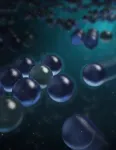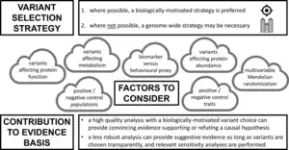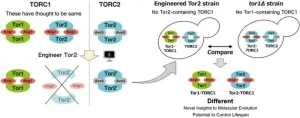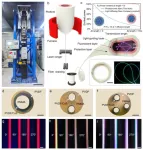(Press-News.org) A study published today in Nature Nanotechnology shows that similarly charged particles can sometimes attract, rather than repel.
The team found that like-charged particles suspended in liquids can attract one another at long-range, depending on the solvent and the sign of the charge.
The study has immediate implications for processes that involve interactions in solution across various length-scales, including self-assembly, crystallisation, and phase separation.
‘Opposites charges attract; like charges repel’ is a fundamental principle of basic physics. But a new study from Oxford University, published today in Nature Nanotechnology, has demonstrated that similarly charged particles in solution can, in fact, attract each other over long distances. Just as surprisingly, the team found that the effect is different for positively and negatively charged particles, depending on the solvent.
Besides overturning long-held beliefs, these results have immediate implications for a range of processes that involve interparticle and intermolecular interactions across various length-scales, including self-assembly, crystallisation, and phase separation.
The team of researchers, based at Oxford’s Department of Chemistry, found that negatively charged particles attract each other at large separations whereas positively charged particles repel, while the reverse was the case for solvents such as alcohols.
These findings are surprising because they seem to contradict the central electromagnetic principle that the force between charges of the same sign is repulsive at all separations.
Now, using bright-field microscopy, the team tracked negatively charged silica microparticles suspended in water and found that the particles attracted each other to form hexagonally arranged clusters. Positively charged aminated silica particles, however, did not form clusters in water.
Using a theory of interparticle interactions that considers the structure of the solvent at the interface, the team established that for negatively charged particles in water there is an attractive force that outweighs electrostatic repulsion at large separations, leading to cluster formation. For positively charged particles in water this solvent-driven interaction is always repulsive, and no clusters form.
This effect was found to be pH dependent: the team were able to control the formation (or not) of clusters for negatively charged particles by varying the pH. No matter the pH, the positively charged particles did not form clusters.
Naturally, the team wondered whether the effect on charged particles could be switched, such that the positively charged particles form clusters and the negatives do not. By changing the solvent to alcohols, such as ethanol, which has different interface behaviour to water, this is exactly what they observed: positively charged aminated silica particles formed hexagonal clusters, whereas negatively charged silica did not.
According to the researchers, this study implies a fundamental re-calibration in understanding that will influence the way we think about processes as different as the stability of pharmaceutical and fine chemical products or the pathological malfunction associated with molecular aggregation in human disease. The new findings also provide evidence for the ability to probe properties of the interfacial electrical potential due to the solvent, such as its sign and magnitude, which were previously thought immeasurable.
Professor Madhavi Krishnan (Department of Chemistry, Oxford University), who led the study, says: ‘I am really very proud of my two graduate students, as well as the undergraduates, who have all worked together to move the needle on this fundamental discovery.’
Sida Wang (Department of Chemistry, Oxford University), a first-author on the study, says: ‘I still find it fascinating to see these particles attract, even having seen this a thousand times.’
ENDS
‘A charge-dependent long-ranged force drives tailored assembly of matter in solution’, DOI: 10.1038/s41565-024-01621-5, will be published online in Nature Nanotechnology at https://www.nature.com/articles/s41565-024-01621-5 from 10am UK time 1 March 2024, and can be accessed under embargo by journalists through Springer Nature’s press site in the usual way.
Journalists can contact:
Prof. Madhavi Krishnan, madhavi.krishnan@chem.ox.ac.uk 01865 285397, or 07423 329114
For all other press queries please contact Dr Thomas Player (Communications Manager, Department of Chemistry, University of Oxford) on chemistry-news@chem.ox.ac.uk
About the University of Oxford
Oxford University has been placed number 1 in the Times Higher Education World University Rankings for the eighth year running, and number 3 in the QS World Rankings 2024. At the heart of this success are the twin-pillars of our ground-breaking research and innovation and our distinctive educational offer.
Oxford is world-famous for research and teaching excellence and home to some of the most talented people from across the globe. Our work helps the lives of millions, solving real-world problems through a huge network of partnerships and collaborations. The breadth and interdisciplinary nature of our research alongside our personalised approach to teaching sparks imaginative and inventive insights and solutions.
Through its research commercialisation arm, Oxford University Innovation, Oxford is the highest university patent filer in the UK and is ranked first in the UK for university spinouts, having created more than 300 new companies since 1988. Over a third of these companies have been created in the past five years. The university is a catalyst for prosperity in Oxfordshire and the United Kingdom, contributing £15.7 billion to the UK economy in 2018/19, and supports more than 28,000 full time jobs.
About the Department of Chemistry, University of Oxford
The department’s mission is to advance the global understanding of chemistry, and to use that knowledge to address major challenges for society. Find out more at www.chem.ox.ac.uk
END
In this study, we determined nine genomes of Japanese wolves and 11 genomes of modern Japanese dogs at high coverage and analyzed with one hundred dog and wolf genomes in the public database. The analyses showed that 1) the Japanese wolf was a unique subspecies of the gray wolf that is genetically distinct from both extant and ancient gray wolves known to date, 2) the Japanese wolf is most closely related to the monophyletic group of dogs. Furthermore, 3) Japanese wolf ancestry has introgressed into the ancestor of East Eurasian dogs at an early stage of the dog’s history ...
Brown bears foraging for food in the Shiretoko Peninsula of Hokkaido, Japan, have been disrupting tree growth in artificial conifer forests, according to a new study. Researchers compared soil and tree samples from human-forested plots with samples from natural forests. They found that the bears’ digging for cicada nymphs damaged tree roots and altered the nitrogen content of the soil, which in turn limited the diameter growth of trees. The phenomena of bears digging for cicadas, an unusual food source, appears to be restricted to human-planted conifer forest; diversely vegetated natural forest ...
Reconstructing a 3D face from visuals is crucial for digital face modeling and manipulation. Traditional methods predominantly depend on RGB images, which are susceptible to lighting variations and offer only 2D information. In contrast, depth images, resistant to lighting changes, directly capture 3D data, offering a potential solution for robust reconstructions. Recent studies have turned to deep learning for more robust reconstruction from depth data; however, the scarcity of real depth images with accurate 3D facial labels has hindered the training process. Attempts to use auto-synthesized data for training have met limitations ...
Assistant Professor Takahiro Kosugi of Institute for Molecular Science, assistant Professor Yoshiaki Kamada at National Institute for Basic Biology, and colleagues have developed an advanced molecular cell biology approach by integrating computational redesigning of protein complexes based on the predicted three-dimensional structure into yeast genetics. They revealed that two types of protein complexes in yeast, which were thought to have the same function, play distinct roles in cellular environmental response and lifespan. Furthermore, ...
Fiber, as the wearable material with the longest application in the history of humankind, is currently an ideal substrate for wearable devices due to its excellent breathability, flexibility, and ability to adapt perfectly to the 3D irregular shape of the human body. As a means of visualization in the field of functional fibers, light-emitting fiber breaks the rigidity of the traditional display interface and is expected to become an emerging interaction interface. The current commercial light-emitting fibers are polymer optical fibers and Corning® Fibrance® light-diffusing fibers. These fibers ...
The General Medical Council (GMC) should revise its terminology regarding international medical graduates (IMGs) in the UK, argues a new commentary published in the Journal of the Royal Society of Medicine (JRSM).
The existing terminology used by the GMC fails to encompass the full spectrum of doctors facing challenges in the UK medical workforce, according to the paper’s author, Professor Mo Al-Haddad of Queen Elizabeth University Hospital, Glasgow.
Notably, he says, the GMC's definition of IMGs overlooks ...
A new study from experts at the University of Exeter has found that a widely used test for prostate cancer may leave black men at increased risk of overdiagnosis.
Prostate-specific antigen (PSA) testing is routinely used as the first step in the UK to investigate men with urinary symptoms such as blood in urine or urinating very frequently. Men aged over 50 years without symptoms are also able to request the blood test from their GP.
The new study, published in BMC Medicine, sought to investigate the performance of the PSA test in identifying prostate cancer among men ...
Niigata, Japan –Dialysis patients often develop dialysis-related amyloidosis and exhibit bone and joint disorders that impair their activity of daily living (Figure 1). Blood purification devices consisting of hexadecyl-immobilized cellulose beads aimed at removing the precursor protein, β2- microglobulin (β2-m), are used in the treatment of dialysis-related amyloidosis. Dr. Yamamoto et al. investigated that comprehensive analysis of proteins adsorbed onto blood purification devices revealed the identification of 200 types of proteins, including β2-m. ...
Magnetite, a tiny particle found in air pollution, can induce signs and symptoms of Alzheimer’s disease, new research suggests.
Alzheimer’s disease, a type of dementia, leads to memory loss, cognitive decline, and a marked reduction in quality of life. It impacts millions globally and is a leading cause of death in older individuals.
The study, Neurodegenerative effects of air pollutant particles: Biological mechanisms implicated for early-onset Alzheimer’s disease, led by Associate Professor Cindy Gunawan and Associate Professor Kristine McGrath from the University of Technology Sydney (UTS) was recently published in Environment ...
A patient with gastrointestinal problems pays his doctor a visit. The doctor orders a stool test that will measure fecal bile acids, compounds made by the liver that can also be modified by the intestinal microbiome and are known for facilitating digestion and absorption of lipids or fats in the small intestine.
Bile acid profiles are altered in several gastrointestinal conditions, including irritable bowel syndrome, Crohn’s disease, and several forms of diarrhea, colitis and some bacterial ...








